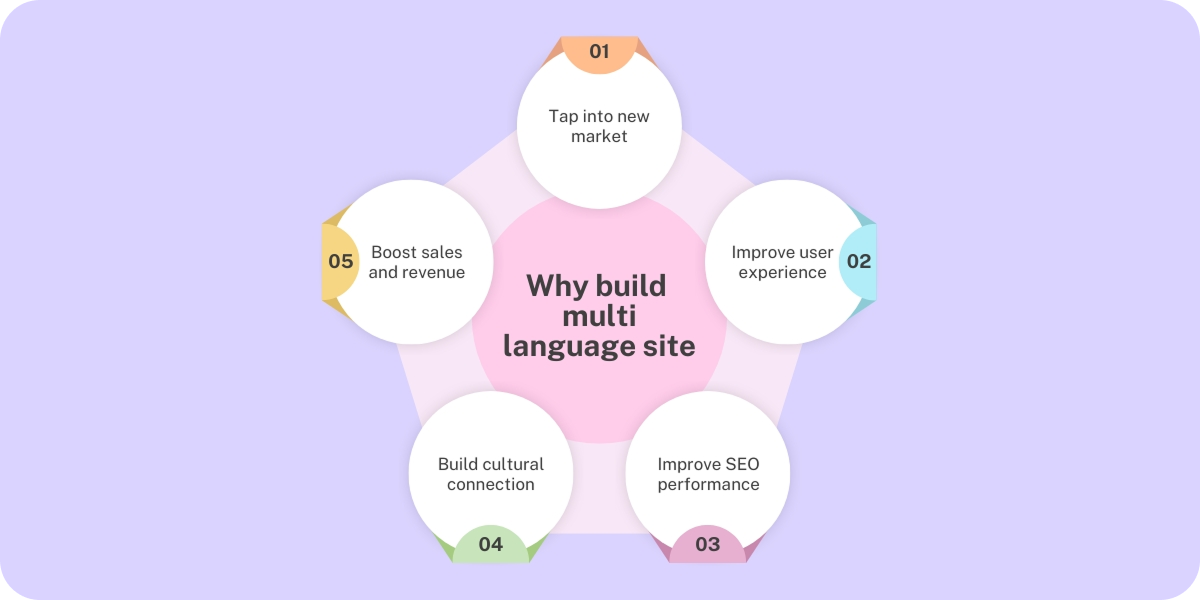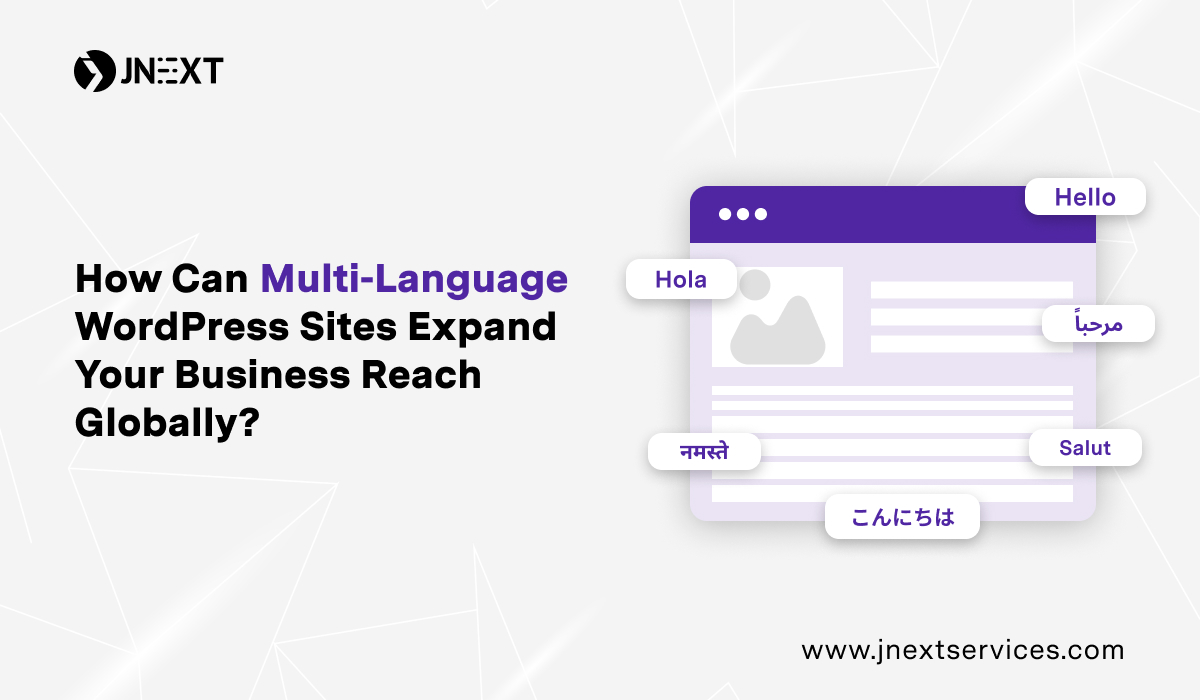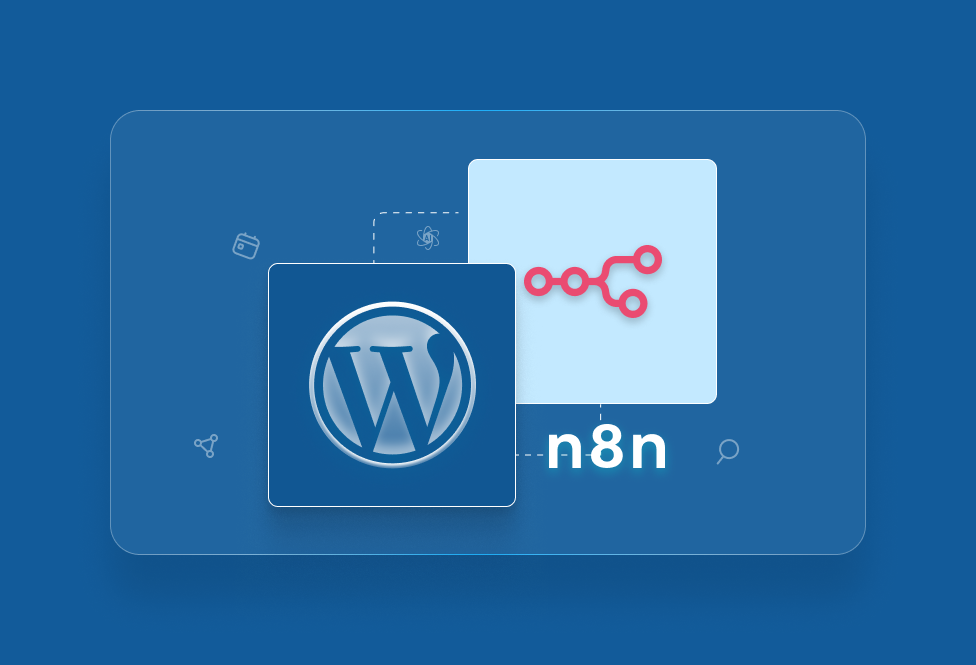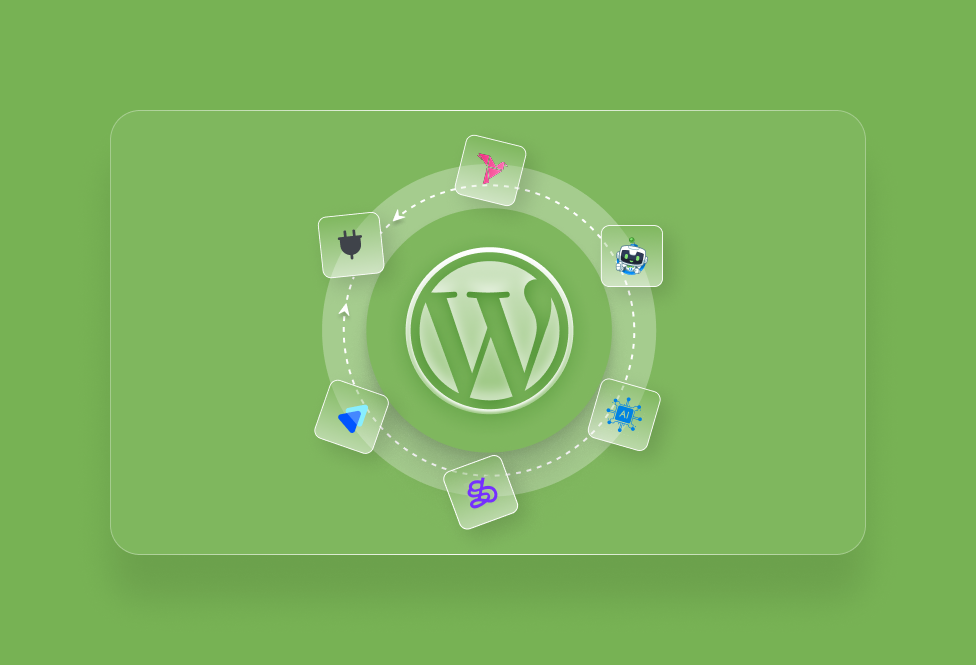Hola Hallo مرحباً नमस्ते Salut こんにちは
I have written “Hi” in 6 different languages, which of the above were you able to relate with?
Didn’t you feel a connection when someone says hi in your language rather than using english everytime?
Now imagine, you visited a website and the content is in your native language.
Wouldn’t that be a great experience as a user, to understand the product offerings and getting a clear idea of everything that’s on site?
But most of the websites that we use today are available in English and non-native speakers sometimes don’t have a grasp of it.
So, as a business if you are planning to reach a global audience and expand your reach, it is important to have a multi-language site.
But why?
Here are the reasons why you should build a multi-language site.
Reasons to build multi-language WordPress Site/Benefits of multi language WordPress Site

Tap into new market
One of the biggest reasons to build multi language sites is to reach customers in their native language. We often think that most searches are in English. But, in fact only 52.1% of web content is in English. Other most common languages are Spanish, German, Japanese, Dutch and more.
So, it shows that English might be the dominant language, but people in different parts of the world prefer to search in their native language. So, building a site that supports multiple languages can help you with growing your reach and tap into the new markets.
Improve user experience
Improve SEO performance
If the users are searching in their native language, but your site is available only in one language, it is unlikely that your business will show up on search engines. Unless the keywords are very low competitive and only a few people have posted about the query that a user is looking for.
And if you regularly track your search console, you might have found that people have found your business, but the keywords they searched for are in another language. It’s because Google automatically translated your site content and now you are seeing the queries in different languages.
Now, you might be thinking that if Google already translates it, why should I do it?
It’s because it increases your chances of ranking in different languages.
Most businesses target the English language for their WordPress site SEO and often miss out on opportunities to rank in other languages. So, even if the keyword volume is high, you still have a chance to rank in region-specific keywords with a multi-language site.
Build cultural connection
Now, translation doesn’t only mean that you translate the content using a tool and then post it. But it’s more about getting into the nerves and understanding the slang that your audience speaks. It helps you connect with them effectively.
For example, you can use denominations in region specific currencies, and use images and symbols that your audience can resonate with. And if you are posting content, you can add humor that is more relatable.
These small tweaks help you connect better with your audience and build a genuine connection with them.
Boost sales and revenue
Language barrier is among the most common barriers that impacts sales.So, having a multi-language site can help you eliminate it. Uses can easily
- Read about your services, products, pricing and more.
- Use localized payment options
It even increases the chances of repeat orders.
Thou there are many multi-language website benefits, it is worth noting that not every business needs a multi-language site. There are several factors that you need to consider before you start putting your resources in building a multi-language site.
So, instead of providing a summary of factors that can help you decide, we have curated a list of questions to help you make the right choice.
Try answering these questions, and if they align with your business goals, you can invest your time and resources into building a multi-language site.
- Who is my target audience, and what languages do they speak?
- Am I planning to expand into international markets?
- Do I already receive significant traffic from non-native language speakers?
- Would translating my content improve user experience and engagement?
- Do competitors in my industry offer multi-language websites?
- Does my business or industry rely on localized cultural or linguistic relevance?
- What are the SEO benefits of having a multi-language site?
- Do I have the resources to create, translate, and maintain content in multiple languages?
- Are there legal requirements in the regions I operate that necessitate content in the local language(s)?
- Can I provide customer support in the additional languages I offer?
After answering these questions you can also refer this list of pros and cons of building multi-language sites.
Refer this guide on modern WordPress development that includes end to end detail for developing a WordPress site in 2025.
Pros and Cons of building a multi-language WordPress site
| Pros | Cons |
| Attracts users from different linguistic and cultural backgrounds. | Involves higher costs for translation, localization, and maintenance. |
| Improves user engagement by providing content in native languages. | Requires significant resources to manage and update content. |
| Enhances SEO by targeting keywords in various languages. | Demands careful attention to avoid translation errors. |
| Builds trust and credibility with localized content. | Slows down development due to localization complexity. |
| Helps in entering and competing in international markets. | Needs technical implementation for language-switching and SEO. |
| Aligns with legal and compliance requirements in some regions. | Requires multilingual customer support for broader audiences. |
| Increases conversions by catering to diverse audiences. | May lead to inconsistencies across different language versions. |
| Offers cultural relevance, improving customer satisfaction. | Risks losing users if translations are inaccurate. |
Best practices to create a multi-language site
Provide an intuitive language switcher
Add a clearly visible language switcher to your site. It should:
- Be located in a prominent position, such as the header or menu.
- Use recognizable icons or abbreviations (e.g., flags or “EN” for English).
- Allow users to switch languages seamlessly without losing their place on the site
Focus on WordPress language localization, not just translation
Language translation for WordPress is about converting text, while localization adapts content to suit cultural preferences. To localize effectively:
- Use culturally relevant imagery, symbols, and units of measurement.
- Adapt content for regional holidays, customs, and slang.
- Translate currencies, payment options, and shipping information.
Implement SEO best practices for multilingual sites
Multilingual SEO ensures your site ranks well in different languages and regions. Key considerations include:
- Use hreflang tags to indicate the language and region of your content.
- Create unique URLs for each language, such as example.com/en/ for English and example.com/fr/ for French.
- Optimize keywords and meta tags for each language.
Optimize performance
- Use caching plugins to improve load times.
- Host images and videos on a content delivery network (CDN).
- Compress translated files and optimize database queries.
Maintaining a multi-language WordPress site requires ongoing maintenance and continuous updates to make sure that our content is error-free and your site keeps running smoothly across different regions.
Our WordPress and maintenance services can take this stress out of your head. Our team of expert WordPress developers keep your site updated with latest content and updates, so you can focus on growing your business. Reach out to our team and lets connect how we can optimize your site for better performance.
Keep the translation updated
Business information, blog posts, and legal disclaimers change over time. Make sure to:
- Regularly update translations to match new content.
- Conduct periodic audits to identify outdated or incorrect translations.
Monitor analytics
- Traffic per language
- Bounce rate and session duration for different regions
- Conversion rates by language
List of Top Multi-Language WordPress Plugins
- WPML: This plugin for translating pages, posts, and custom fields.
- Polylang: A user-friendly solution for creating and managing translations.
- TranslatePress: Offers a visual interface for translating your site.
- Weglot: Provides automatic translations and integrates seamlessly with WordPress.
While these plugins offer quick way to create multi-language WordPress, you still need experienced developers to set them up and customize them based on your preferences. Hire skilled WordPress developers from our team who can help you quickly setup the plugin and go live in no time.
Conclusion
Building a multi-language site is not just about changing the content, it’s a strategic move to connect with your audience and improve your brand presence. So, whether you are planning to build an eCommerce store or expand your service offerings, a multi-language site is a must-have for you.


 January 24, 2025
January 24, 2025





TEAM id
jnext_services
email us [email protected]
india
+91 98587 63596
United Kingdom
+ 44 77679 57915